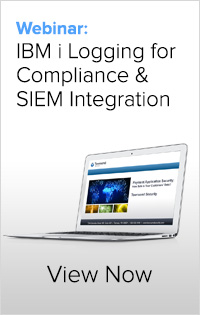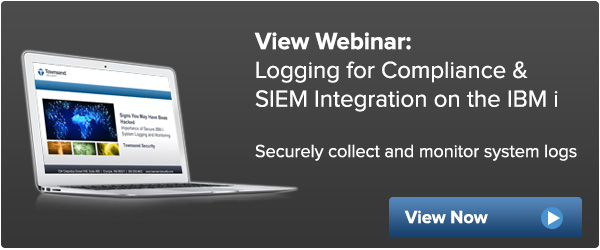IBM i (iSeries, AS/400) users are often confused about user names in the IBM security audit journal QAUDJRN, and how they are reported to their log collection server or SIEM solution by Alliance LogAgent. To understand this it is important to know that every batch or interactive job on the IBM i platform actually has two user names: a job user name and a current user name (sometimes called the effective user). These two user names are often the same, but there are many times when they are different. Let’s take a look at some examples.
 The IBM FTP server runs under the IBM user name QTCP as it waits for a connection from an FTP client. The user name QTCP is provided by IBM and is used for a number of network services. When an FTP client connects to the IBM FTP server and logs in, the job user remains QTCP but the current user is now the name of the actual user who logged in to the FTP session. If a user named BILL logged in you would then have these two user names:
The IBM FTP server runs under the IBM user name QTCP as it waits for a connection from an FTP client. The user name QTCP is provided by IBM and is used for a number of network services. When an FTP client connects to the IBM FTP server and logs in, the job user remains QTCP but the current user is now the name of the actual user who logged in to the FTP session. If a user named BILL logged in you would then have these two user names:
Job user name: QTCP
Current user name: BILL
Both of these user names are recorded in the IBM security audit journal. You can see this information when you use the Display Audit Journal Entries command DSPAUDJRNE. Try selecting the job start event “JS” and you will see this in the output:
| Entry Type | Effective User | Job Type | Job SubType | Job Name | Job User | Job Number | Job Name | Job User |
| JS | M | BILL | B | QTFTP00548 | QTCP | 803244 | QTFTP00548 | QTCP |
But there is a big difference in the capabilities and security risk between these two users. The user QTCP is an IBM supplied user with no ability to log into the system, and the user BILL is an actual user whose authorities and capabilities are in effect. If BILL is a highly privileged user he will have the ability to do a lot of damage and may even be able to retrieve any database file on the system.
Monitoring both user names in your SIEM solution and retaining the history of the activity on these two users is critical for your security strategy on the IBM i.
In Alliance LogAgent we collect and report both of these names when sending information to your log collection server and SIEM solution in the Syslog format. When you look at these events you will see something like this:
user_name=”QTCP”
effective_user=”BILL”
If you are using the Common Event Format (CEF) that is preferred by HP ArcSight’s SIEM solution, you will see information like this:
suser=QTCP
eff_user=BILL
If you are using the new IBM QRadar log event extended format (LEEF), Alliance LogAgent will send the information like this:
user=QTCP
usrName=BILL
The “usrName” keyword is predefined to IBM QRadar and is the user credential that is monitored for anomalies and suspicious behavior. So it is important that the effective user be supplied in this case.
Both user names contain important security information, and both should be reported to your SIEM solution for active monitoring. Alliance LogAgent always sends both user names to make your monitoring and security strategy more effective.

